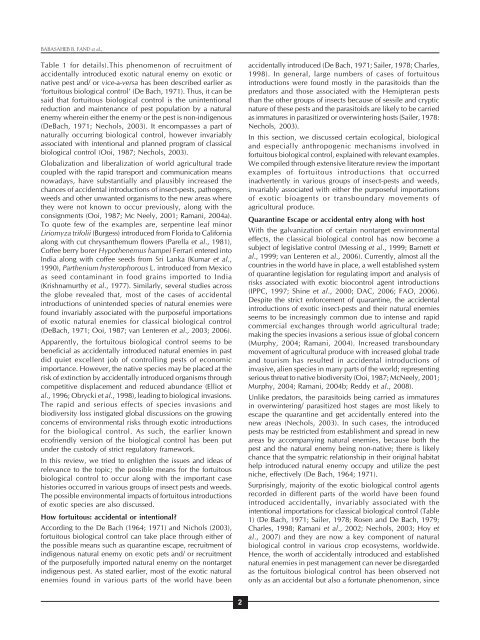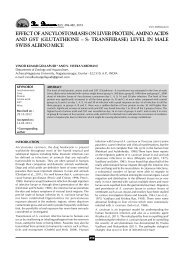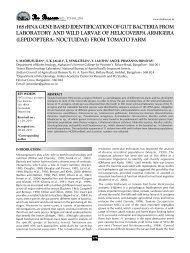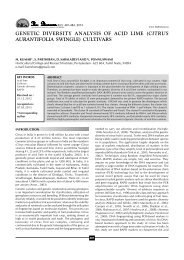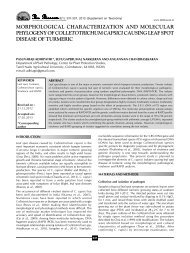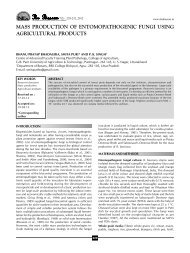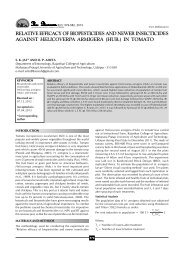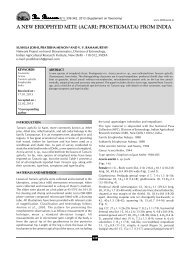Fortuitous biological control of insect pests and ... - THE BIOSCAN
Fortuitous biological control of insect pests and ... - THE BIOSCAN
Fortuitous biological control of insect pests and ... - THE BIOSCAN
- No tags were found...
Create successful ePaper yourself
Turn your PDF publications into a flip-book with our unique Google optimized e-Paper software.
BABASAHEB B. FAND et al.,Table 1 for details).This phenomenon <strong>of</strong> recruitment <strong>of</strong>accidentally introduced exotic natural enemy on exotic ornative pest <strong>and</strong>/ or vice-a-versa has been described earlier as‘fortuitous <strong>biological</strong> <strong>control</strong>’ (De Bach, 1971). Thus, it can besaid that fortuitous <strong>biological</strong> <strong>control</strong> is the unintentionalreduction <strong>and</strong> maintenance <strong>of</strong> pest population by a naturalenemy wherein either the enemy or the pest is non-indigenous(DeBach, 1971; Nechols, 2003). It encompasses a part <strong>of</strong>naturally occurring <strong>biological</strong> <strong>control</strong>, however invariablyassociated with intentional <strong>and</strong> planned program <strong>of</strong> classical<strong>biological</strong> <strong>control</strong> (Ooi, 1987; Nechols, 2003).Globalization <strong>and</strong> liberalization <strong>of</strong> world agricultural tradecoupled with the rapid transport <strong>and</strong> communication meansnowadays, have substantially <strong>and</strong> plausibly increased thechances <strong>of</strong> accidental introductions <strong>of</strong> <strong>insect</strong>-<strong>pests</strong>, pathogens,weeds <strong>and</strong> other unwanted organisms to the new areas wherethey were not known to occur previously, along with theconsignments (Ooi, 1987; Mc Neely, 2001; Ramani, 2004a).To quote few <strong>of</strong> the examples are, serpentine leaf minorLiriomyza trifolii (Burgess) introduced from Florida to Californiaalong with cut chrysanthemum flowers (Parella et al., 1981),C<strong>of</strong>fee berry borer Hypothenemus hampei Ferrari entered intoIndia along with c<strong>of</strong>fee seeds from Sri Lanka (Kumar et al.,1990), Parthenium hysterophorous L. introduced from Mexicoas seed contaminant in food grains imported to India(Krishnamurthy et al., 1977). Similarly, several studies acrossthe globe revealed that, most <strong>of</strong> the cases <strong>of</strong> accidentalintroductions <strong>of</strong> unintended species <strong>of</strong> natural enemies werefound invariably associated with the purposeful importations<strong>of</strong> exotic natural enemies for classical <strong>biological</strong> <strong>control</strong>(DeBach, 1971; Ooi, 1987; van Lenteren et al., 2003; 2006).Apparently, the fortuitous <strong>biological</strong> <strong>control</strong> seems to bebeneficial as accidentally introduced natural enemies in pastdid quiet excellent job <strong>of</strong> <strong>control</strong>ling <strong>pests</strong> <strong>of</strong> economicimportance. However, the native species may be placed at therisk <strong>of</strong> extinction by accidentally introduced organisms throughcompetitive displacement <strong>and</strong> reduced abundance (Elliot etal., 1996; Obrycki et al., 1998), leading to <strong>biological</strong> invasions.The rapid <strong>and</strong> serious effects <strong>of</strong> species invasions <strong>and</strong>biodiversity loss instigated global discussions on the growingconcerns <strong>of</strong> environmental risks through exotic introductionsfor the <strong>biological</strong> <strong>control</strong>. As such, the earlier knownec<strong>of</strong>riendly version <strong>of</strong> the <strong>biological</strong> <strong>control</strong> has been putunder the custody <strong>of</strong> strict regulatory framework.In this review, we tried to enlighten the issues <strong>and</strong> ideas <strong>of</strong>relevance to the topic; the possible means for the fortuitous<strong>biological</strong> <strong>control</strong> to occur along with the important casehistories occurred in various groups <strong>of</strong> <strong>insect</strong> <strong>pests</strong> <strong>and</strong> weeds.The possible environmental impacts <strong>of</strong> fortuitous introductions<strong>of</strong> exotic species are also discussed.How fortuitous: accidental or intentional?According to the De Bach (1964; 1971) <strong>and</strong> Nichols (2003),fortuitous <strong>biological</strong> <strong>control</strong> can take place through either <strong>of</strong>the possible means such as quarantine escape, recruitment <strong>of</strong>indigenous natural enemy on exotic pets <strong>and</strong>/ or recruitment<strong>of</strong> the purposefully imported natural enemy on the nontargetindigenous pest. As stated earlier, most <strong>of</strong> the exotic naturalenemies found in various parts <strong>of</strong> the world have beenaccidentally introduced (De Bach, 1971; Sailer, 1978; Charles,1998). In general, large numbers <strong>of</strong> cases <strong>of</strong> fortuitousintroductions were found mostly in the parasitoids than thepredators <strong>and</strong> those associated with the Hemipteran <strong>pests</strong>than the other groups <strong>of</strong> <strong>insect</strong>s because <strong>of</strong> sessile <strong>and</strong> crypticnature <strong>of</strong> these <strong>pests</strong> <strong>and</strong> the parasitoids are likely to be carriedas immatures in parasitized or overwintering hosts (Sailer, 1978:Nechols, 2003).In this section, we discussed certain ecological, <strong>biological</strong><strong>and</strong> especially anthropogenic mechanisms involved infortuitous <strong>biological</strong> <strong>control</strong>, explained with relevant examples.We compiled through extensive literature review the importantexamples <strong>of</strong> fortuitous introductions that occurredinadvertently in various groups <strong>of</strong> <strong>insect</strong>-<strong>pests</strong> <strong>and</strong> weeds,invariably associated with either the purposeful importations<strong>of</strong> exotic bioagents or transboundary movements <strong>of</strong>agricultural produce.Quarantine Escape or accidental entry along with hostWith the galvanization <strong>of</strong> certain nontarget environmentaleffects, the classical <strong>biological</strong> <strong>control</strong> has now become asubject <strong>of</strong> legislative <strong>control</strong> (Messing et al., 1999; Barnett etal., 1999; van Lenteren et al., 2006). Currently, almost all thecountries in the world have in place, a well established system<strong>of</strong> quarantine legislation for regulating import <strong>and</strong> analysis <strong>of</strong>risks associated with exotic bio<strong>control</strong> agent introductions(IPPC, 1997; Shine et al., 2000; DAC, 2006; FAO, 2006).Despite the strict enforcement <strong>of</strong> quarantine, the accidentalintroductions <strong>of</strong> exotic <strong>insect</strong>-<strong>pests</strong> <strong>and</strong> their natural enemiesseems to be increasingly common due to intense <strong>and</strong> rapidcommercial exchanges through world agricultural trade;making the species invasions a serious issue <strong>of</strong> global concern(Murphy, 2004; Ramani, 2004). Increased transboundarymovement <strong>of</strong> agricultural produce with increased global trade<strong>and</strong> tourism has resulted in accidental introductions <strong>of</strong>invasive, alien species in many parts <strong>of</strong> the world; representingserious threat to native biodiversity (Ooi, 1987; McNeely, 2001;Murphy, 2004; Ramani, 2004b; Reddy et al., 2008).Unlike predators, the parasitoids being carried as immaturesin overwintering/ parasitized host stages are most likely toescape the quarantine <strong>and</strong> get accidentally entered into thenew areas (Nechols, 2003). In such cases, the introduced<strong>pests</strong> may be restricted from establishment <strong>and</strong> spread in newareas by accompanying natural enemies, because both thepest <strong>and</strong> the natural enemy being non-native; there is likelychance that the sympatric relationship in their original habitathelp introduced natural enemy occupy <strong>and</strong> utilize the pestniche, effectively (De Bach, 1964; 1971).Surprisingly, majority <strong>of</strong> the exotic <strong>biological</strong> <strong>control</strong> agentsrecorded in different parts <strong>of</strong> the world have been foundintroduced accidentally, invariably associated with theintentional importations for classical <strong>biological</strong> <strong>control</strong> (Table1) (De Bach, 1971; Sailer, 1978; Rosen <strong>and</strong> De Bach, 1979;Charles, 1998; Ramani et al., 2002; Nechols, 2003; Hoy etal., 2007) <strong>and</strong> they are now a key component <strong>of</strong> natural<strong>biological</strong> <strong>control</strong> in various crop ecosystems, worldwide.Hence, the worth <strong>of</strong> accidentally introduced <strong>and</strong> establishednatural enemies in pest management can never be disregardedas the fortuitous <strong>biological</strong> <strong>control</strong> has been observed notonly as an accidental but also a fortunate phenomenon, since2


